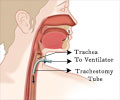Tracheostomy Indications
Now a days tracheostomy is done only in those cases in which intubation by a mouth or nasal tube is not a feasible option.
- There are broadly four groups of patients on whom tracheostomy needs to be performed:
1. To relieve breathing difficulties by any blockage in the airway passages for example-
- Foreign body Impactation in the airways.
- Acute infection of the airways
- Edema of the airways
- Paralysis of vocal cords following injury
- Tumors of the vocal cords
- Trauma in the region
2. To improve respiratory functions by reducing the length of the airway, which may be required in special lung conditions like- Bronchopneumonia
- Bronchitis with Emphysema
- Chest injury
In these conditions the tracheostomy tube also helps in aspiration of excessive secretion that may be caused due to infection or injury
3. Respiratory nerve damage temporary or permanent causing paralysis of chest muscles that assist in breathing. In these situations performing assisted or positive pressure respirations may be required in conditions like -
- Unconsciousness associated with head injuries
- Barbiturate poisoning
- Poliomyelitis
- Tetanus
These patients may also aspirate their gastric content into the lungs and a tracheostomy tube may be helpful for aspiration these secretions.
4. As a preliminary step in certain surgeries on the upper airway.
Advantages of Tracheostomy
Tracheostomy has certain advantageous over the temporary tube called endotracheal tube because it -
- Reduces patient discomfort
- Reduces need for sedation
- Improves ability to maintain oral and bronchial hygiene
- Reduces risk of trauma to the windpipe and trachea
- Makes breathing easier with less effort for a sick patient
- Easier to move off assisted breathing using a ventilator.
 MEDINDIA
MEDINDIA
 Email
Email








